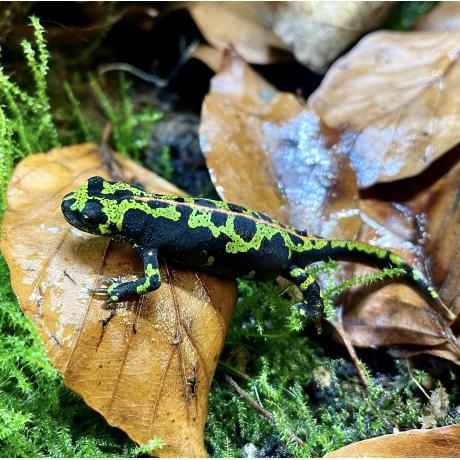

A large, robust and beautiful European species of newt that is easy to keep and breed.
| Origin | Southern Europe, including Portugal, Spain and France |
|---|---|
| Environment | Mostly terrestrial |
| Adult Size | 12-17cm |
| Suitability | Beginner |
| Lifespan | Up to 20 years |
These beautiful newts have a dark brown or black base colouration with irregular patterns of marbled green. The venter (the underside or abdomen of an animal) is a mottled grey, black and cream.
Adult females and juveniles have orange or yellow stripes running along the dorsal from head to tail, in adult males the stripe colouration fades as they reach maturity. Males develop obvious swollen cloaca and during the breeding season a crest which is very high and barred. This becomes a low ridge for the remainder of the year.
These newts reach lengths between 12-17cm.
In the wild Marbled Newts are found throughout southern Europe including Portugal, Spain and France.
Their natural habitat includes well-vegetated ponds, pools, ditches and streams within shaded woodland, heath land, fields and grasslands. It is not uncommon to find these newts at high elevations where temperatures are extremely low during the winter.
Marbled Newts tend to spend more time in their terrestrial (on land) state when compared to other newt species. In the wild and during spring each year, the newts would naturally move from their terrestrial state into pools and streams to breed.
In captivity, these newts can be easily kept in a simple glass terrarium. Expensive heating or lighting equipment is not necessary but we would still advise providing a low percentage UVB light via an overhead canopy. Temperatures should not exceed 22C during the summer, over the winter they can be hibernated and will tolerate temperatures as low at 5C. If you wish to breed your newts, then you would need to move them to an aquatic setup during the spring.
Provide a minimum substrate layer of 7-10cm. This must be soil based and kept damp but not waterlogged. Add sphagnum moss along with rocks, bark and logs.
Alternatively, you could create a bio-active setup by adding live plants and creating further interest in the terrarium. When doing this you must remember that you will need to provide additional lighting to the terrarium to aid with plant growth.
A good sized water dish must be provided as newts enter often enter water to shed their skin. Remember all water needs to be treated with a good quality dechlorinator to remove harmful chemicals from the water before use,
Livefood should be offered in the form of Black Crickets, Curly-wing flies, Locusts and Silent Crickets. Choosing the correct size insect is important, if they are too large they will be ignored. Remember that you must ensure all of your insects are well gutloaded before feeding them to your animals.
Offer livefood to your newts every other day and ideally remove any uneaten livefood by the next morning. However, we’d advise using personal judgement here as it pays not to constantly disturb their habitat as this will inevitably cause unnecessary stress. You can adjust levels of feeding depending on how much is being consumed, once they are established.
Lastly and most importantly you must use a good quality dusting powder to provide essential calcium and vitamins to your newts. The traditional method of application is to use a spare livefood tub or empty cereal container to coat the insects lightly in whichever dusting powder you are providing. We’d advise dusting your insects on every feed but to alternate between calcium and vitamin powders with the ratio of (2.1).